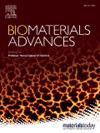Understanding the structure and mechanics of the sheep calcaneal enthesis: a relevant animal model to design scaffolds for tissue engineering applications
IF 6
2区 医学
Q2 MATERIALS SCIENCE, BIOMATERIALS
Materials Science & Engineering C-Materials for Biological Applications
Pub Date : 2025-04-17
DOI:10.1016/j.bioadv.2025.214320
引用次数: 0
Abstract
Tendon or enthesis injuries are a worldwide clinical problem. Along the enthesis, collagen fibrils show a progressive loss of anisotropy and an increase in mineralization reaching the bone. This causes gradients of mechanical properties. The design of scaffolds to regenerate these load-bearing tissues requires validation in vivo in relevant large animal models. The sheep tendon of triceps surae muscle is an optimal animal model for this scope with limited knowledge about its structure and mechanics. We decided to investigate in-depth its structure and full-field mechanics. Collagen fibrils morphology was investigated via scanning electron microscopy revealing a marked change in orientation/dimensions passing from the tendon to the enthesis. Backscatter electron images and nanoindentation at the enthesis/bone marked small gradients of mineralization at the mineralized fibrocartilage reaching 27%wt and indentation modulus around 17–30 GPa. The trabecular bone instead had indentation modulus around 15–22 GPa. Mechanical tensile tests with digital image correlation confirmed the typical non-linear behavior of tendons (failure strain = 8.2 ± 1.0 %; failure force = 1369 ± 187 N) with maximum principal strains reaching mean values of εp1 ∼ 7 %. The typical auxetic behavior of tendon was highlighted by the minimum principal strains (εp2 ∼ 5 %), progressively dampened at the enthesis. Histology revealed that this behavior was caused by a local thickening of the epitenon. Cyclic tests showed a force loss of 21 ± 7 % at the last cycle. These findings will be fundamental for biofabrication and clinicians interested in designing the new generation of scaffolds for enthesis regeneration.

了解绵羊小关节内膜的结构和力学:设计组织工程应用支架的相关动物模型
肌腱或髋部损伤是一个世界性的临床问题。沿着端部,胶原原纤维的各向异性逐渐丧失,到达骨的矿化增加。这就造成了机械性能的梯度。设计用于再生这些承重组织的支架需要在相关的大型动物模型中进行体内验证。由于对其结构和力学的了解有限,羊三头肌表面肌腱是该范围的最佳动物模型。我们决定深入研究它的结构和全场力学。通过扫描电镜观察胶原原纤维的形态,发现从肌腱到椎体的方向/尺寸发生了显著变化。后向散射电子图像和骨端/骨的纳米压痕显示矿化纤维软骨的矿化梯度较小,达到27%wt,压痕模量约为17-30 GPa。而小梁骨的压痕模量约为15 - 22gpa。数字图像相关的力学拉伸试验证实了肌腱的典型非线性行为(破坏应变= 8.2±1.0%;破坏力= 1369±187 N),最大主应变达到平均值εp1 ~ 7%。最小主应变(εp2 ~ 5%)突出了肌腱的典型减振行为,在末端逐渐衰减。组织学显示,这种行为是由局部增厚的外稃。循环试验表明,在最后一个循环中,力损失为21±7%。这些发现将对生物制造和临床医生设计新一代支架内皮再生具有重要意义。
本文章由计算机程序翻译,如有差异,请以英文原文为准。
求助全文
约1分钟内获得全文
求助全文
来源期刊
CiteScore
17.80
自引率
0.00%
发文量
501
审稿时长
27 days
期刊介绍:
Biomaterials Advances, previously known as Materials Science and Engineering: C-Materials for Biological Applications (P-ISSN: 0928-4931, E-ISSN: 1873-0191). Includes topics at the interface of the biomedical sciences and materials engineering. These topics include:
• Bioinspired and biomimetic materials for medical applications
• Materials of biological origin for medical applications
• Materials for "active" medical applications
• Self-assembling and self-healing materials for medical applications
• "Smart" (i.e., stimulus-response) materials for medical applications
• Ceramic, metallic, polymeric, and composite materials for medical applications
• Materials for in vivo sensing
• Materials for in vivo imaging
• Materials for delivery of pharmacologic agents and vaccines
• Novel approaches for characterizing and modeling materials for medical applications
Manuscripts on biological topics without a materials science component, or manuscripts on materials science without biological applications, will not be considered for publication in Materials Science and Engineering C. New submissions are first assessed for language, scope and originality (plagiarism check) and can be desk rejected before review if they need English language improvements, are out of scope or present excessive duplication with published sources.
Biomaterials Advances sits within Elsevier''s biomaterials science portfolio alongside Biomaterials, Materials Today Bio and Biomaterials and Biosystems. As part of the broader Materials Today family, Biomaterials Advances offers authors rigorous peer review, rapid decisions, and high visibility. We look forward to receiving your submissions!

 求助内容:
求助内容: 应助结果提醒方式:
应助结果提醒方式:


